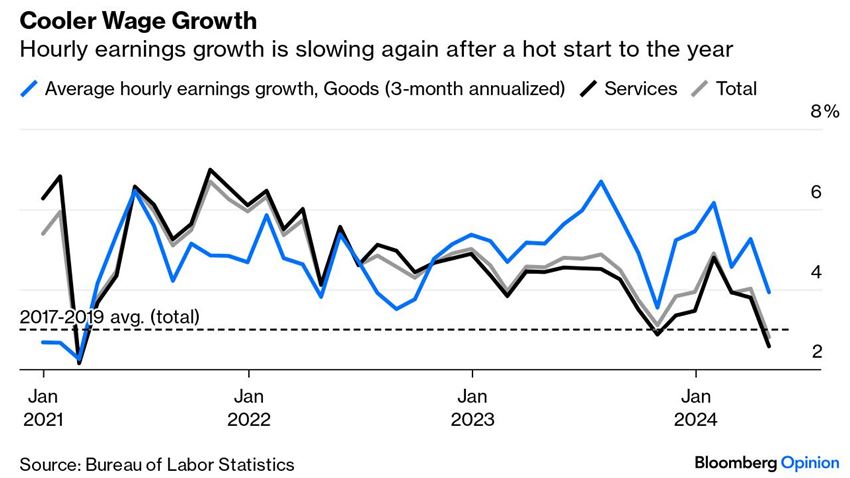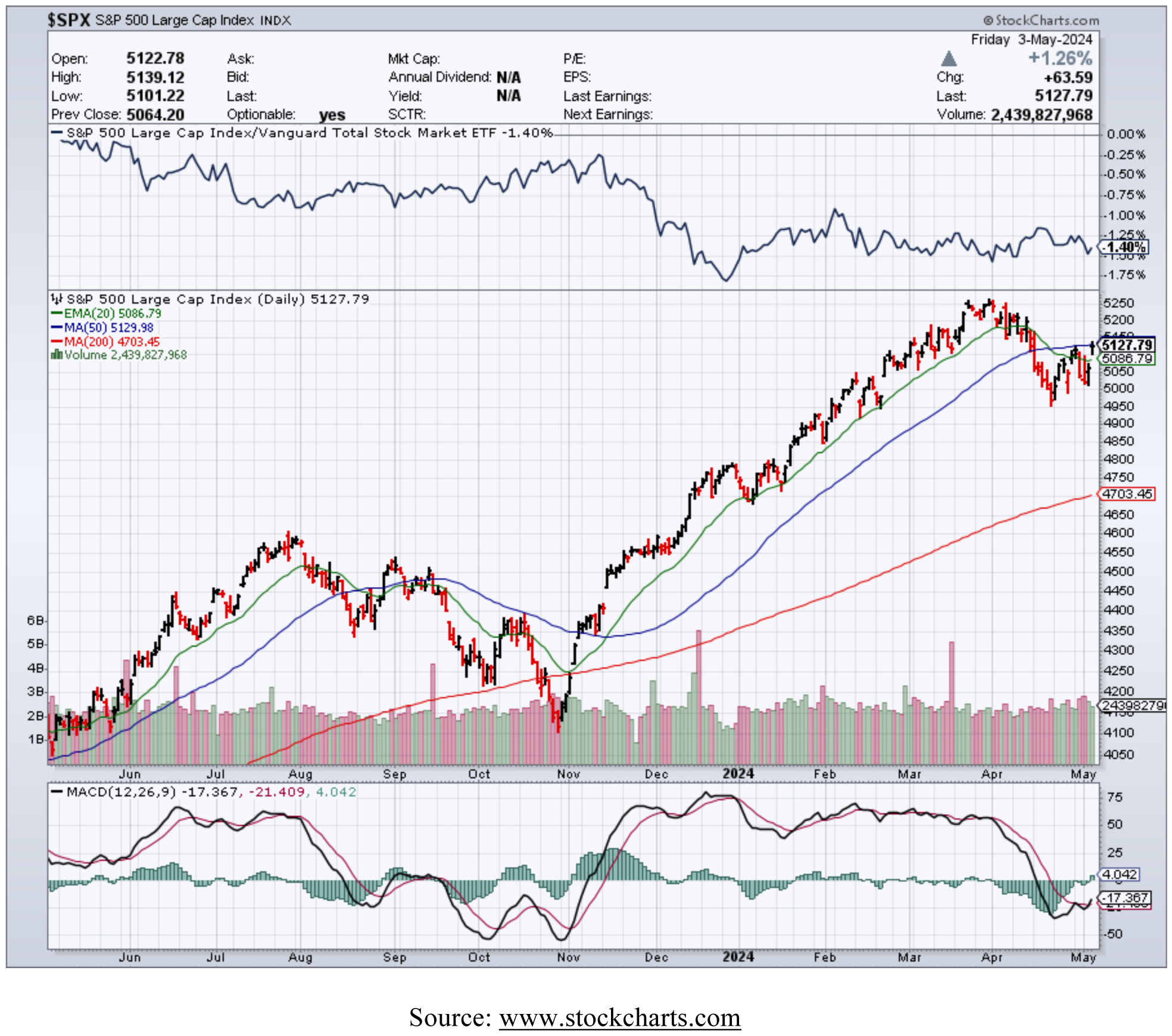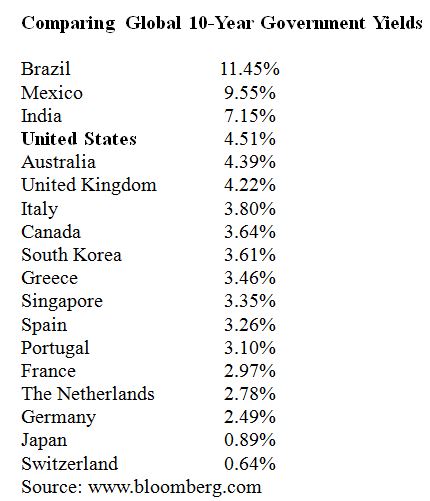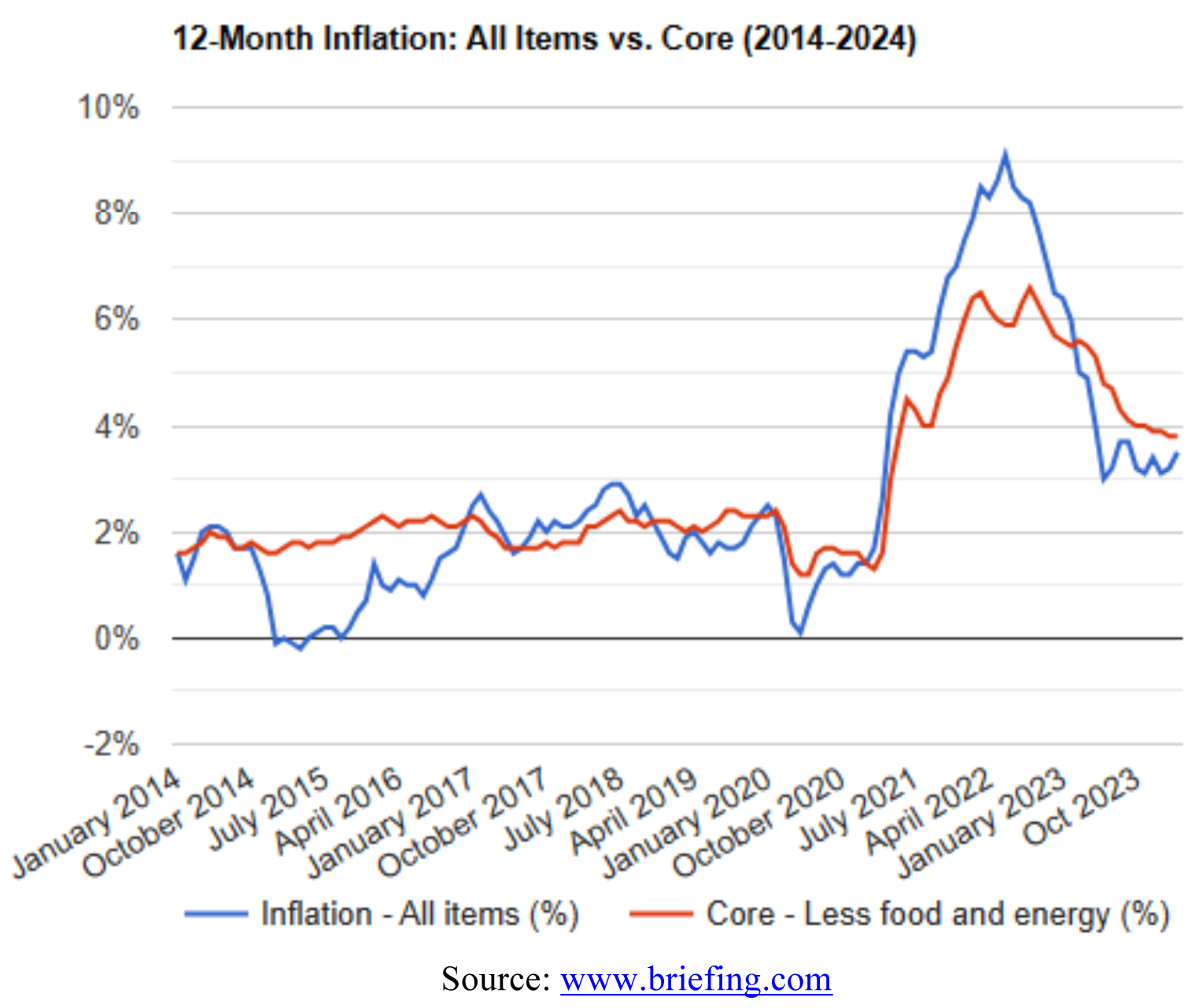by Bryan Perry
May 7, 2024
Over the past two weeks, investors have been on the receiving end of several key economic reports and high-profile earnings releases that have roiled the stock market, generating wide daily price swings.
For instance, there have been conflicting data on labor markets, in which the Employment Cost Index released on April 30 showed that compensation costs accelerated from the fourth quarter, leading to concerns about general price inflation staying above the Fed’s 2% target for longer than expected.
In response, bond yields spiked and the stock market swooned, but both the bond and stock markets steadied after Wednesday’s Federal Open Market Committee (FOMC) press release and press conference, and Friday’s release of the labor market data, which revealed non-farm payrolls increasing by a smaller-than-expected 175,000 jobs, with average hourly earnings up just 0.2%, the unemployment rate ticking up to 3.9%, and the average workweek coming in at a smaller-than-expected 34.3 hours.

Graphs are for illustrative and discussion purposes only. Please read important disclosures at the end of this commentary.
First off, the Federal Reserve policy statement from Chairman Jerome Powell was essentially what the market expected, holding Fed Funds unchanged at 5.25%-5.50%, with some hint that a rate cut for 2024 was not completely out of the question. The body of his message was that the central bank is pushing back its plans for rate cuts as inflation plateaus well above the bank’s 2% target rate. Meanwhile, the higher for longer narrative has helped to shore up the dollar against other currencies. The problem is debt.
For the current April-June quarter, the Treasury expects to borrow $243 billion in privately held net marketable debt. This estimate is $41 billion higher than the announcement made in January and begs the question of the level of new Treasury debt the global market can absorb. Thankfully, this topic is starting to matter to more key people, but it will likely be tabled until 2025, since 2024 is an election year.
This earnings season has also been a roller coaster in that coming into it, the bar was set pretty low. So far, roughly 77% of S&P 500 companies have reported positive earnings surprises and 61% have posted positive revenue surprises, but some Wall Street darlings cast a shadow of doubt over future earnings guidance. And yet, the S&P 500 benchmark index held its key support level at 5,000 to close the week at 5,127 and reclaim its 50-day moving average on the back of strong upside moves from non-Mag 7 stocks.
Investors should be grateful for the broadly bullish tone of earnings season. Though I noted some popular stocks that impressed or disappointed the Wall Street lemmings, on balance, business conditions for most companies that have reported first-quarter numbers are upbeat. However, it is very important for all of us to know and respect how quickly sentiment can shift if certain assumptions fall short of expectations.
With the first-quarter reporting season almost complete, the market’s bullish bias will now need to depend on economic data providing any new catalysts to keep the uptrend intact. Translated, the market needs to see data on inflation move in the right direction during the month of May. If so, bonds can rally further, which would remove a big market headwind. Friday’s dovish employment report and the pullback in oil prices last week is a good start, which served to move the needle in favor of the bulls for the near term.
 Graphs are for illustrative and discussion purposes only. Please read important disclosures at the end of this commentary.
Graphs are for illustrative and discussion purposes only. Please read important disclosures at the end of this commentary.
Whether rates have topped out is anyone’s guess at this point, the protracted sell off in the bond market leading up to the big jump in bond prices, per the employment data, shows just how jittery the bond market is and how it has become the ruling instrument of market sentiment and the driver of the narrative.
The benchmark 10-year sovereign rate is what drives sentiment for most bond traders, as it is a long-term predictor of risk that is not controlled by central banks, as is the case for short-term rates. A quick look at this list shows the U.S. dollar delivering the highest yield outside three rather risky emerging markets.

To this point, I think the way the market has handled the shift in the Fed’s interest rate cut expectations is remarkable. Six months ago, the bond futures market pivoted hard in the early fall of 2023, anticipating no fewer than six quarter-point rate cuts in 2024. The greatest odds implied by the futures markets in the final quarter of 2023 priced in a year-end 2024 Fed funds rate of 3.75%-4.00%, representing six cuts, a 1.5% reduction from current levels in response to what was widely believed to be major slowdown.
As we all know by now, a recession did not materialize – despite 11 rate hikes. We are now on the doorstep of summer with the latest set of economic data points forecasting a slowing of sorts that might help resolve the inflation problem that has handcuffed the Fed – and also frustrated millions of families across the country having to manage higher prices in so many areas of the economy at the local level.
Core inflation is monitored alongside headline inflation, which measures the changes in the prices of all goods and services in an economy. The headline inflation rate is typically more volatile than core inflation due to the impact of food and energy prices, which can fluctuate far more rapidly. The irony of this carve-out of food and energy is that consumers care greatly about these two metrics in their weekly budgets.

Graphs are for illustrative and discussion purposes only. Please read important disclosures at the end of this commentary.
The Fed is looking at the same charts that show headline and core inflation leveling out at the 3.8%-4.0% range (above). In past times, this would seem to be a “new normal” that could be lived with. But it is my view that internally, the Fed is terrified of the size, growth rate, and cost to service the $34+ trillion in federal debt, and there seems to be very little, if any, coordination or collaboration between the Federal Reserve, the Treasury and Congress to as to how to best manage fiscal and monetary policy right now.
This week’s upcoming auctions of $67 billion in 10- and 30-year Treasury Bonds, along with $58 billion in 3-year Notes – for a total of $125 billion in new supply – will certainly test the appetite of global buyers of longer-term U.S. debt at a time when inflation is, for lack of better expression, a “jump ball.”
One good (soft) employment report last Friday does not make for a trend. The bond market caught a solid bid on the weaker jobs data and other recent evidence of slowing growth. Some newfound conviction emerged last week that maybe, just maybe, the inflation genie can be put back in the bottle. Let’s hope so.
All content above represents the opinion of Bryan Perry of Navellier & Associates, Inc.
Also In This Issue
A Look Ahead by Louis Navellier
Powell’s Performance Boosts the Market Amid Downbeat Economic Reports
Income Mail by Bryan Perry
The Market Holds Up as Economic Cross Currents Collide
Growth Mail by Gary Alexander
Why the U.S. is an Economic and Investment Oasis – And Likely Will Remain So
Global Mail by Ivan Martchev
It Looks Like That Was “It” for the April Correction
Sector Spotlight by Jason Bodner
Powell’s Upbeat Music Lifted the Market
View Full Archive
Read Past Issues Here

Bryan Perry
SENIOR DIRECTOR
Bryan Perry is a Senior Director with Navellier Private Client Group, advising and facilitating high net worth investors in the pursuit of their financial goals.
Bryan’s financial services career spanning the past three decades includes over 20 years of wealth management experience with Wall Street firms that include Bear Stearns, Lehman Brothers and Paine Webber, working with both retail and institutional clients. Bryan earned a B.A. in Political Science from Virginia Polytechnic Institute & State University and currently holds a Series 65 license. All content of “Income Mail” represents the opinion of Bryan Perry
Important Disclosures:
Although information in these reports has been obtained from and is based upon sources that Navellier believes to be reliable, Navellier does not guarantee its accuracy and it may be incomplete or condensed. All opinions and estimates constitute Navellier’s judgment as of the date the report was created and are subject to change without notice. These reports are for informational purposes only and are not a solicitation for the purchase or sale of a security. Any decision to purchase securities mentioned in these reports must take into account existing public information on such securities or any registered prospectus.To the extent permitted by law, neither Navellier & Associates, Inc., nor any of its affiliates, agents, or service providers assumes any liability or responsibility nor owes any duty of care for any consequences of any person acting or refraining to act in reliance on the information contained in this communication or for any decision based on it.
Past performance is no indication of future results. Investment in securities involves significant risk and has the potential for partial or complete loss of funds invested. It should not be assumed that any securities recommendations made by Navellier. in the future will be profitable or equal the performance of securities made in this report. Dividend payments are not guaranteed. The amount of a dividend payment, if any, can vary over time and issuers may reduce dividends paid on securities in the event of a recession or adverse event affecting a specific industry or issuer.
None of the stock information, data, and company information presented herein constitutes a recommendation by Navellier or a solicitation to buy or sell any securities. Any specific securities identified and described do not represent all of the securities purchased, sold, or recommended for advisory clients. The holdings identified do not represent all of the securities purchased, sold, or recommended for advisory clients and the reader should not assume that investments in the securities identified and discussed were or will be profitable.
Information presented is general information that does not take into account your individual circumstances, financial situation, or needs, nor does it present a personalized recommendation to you. Individual stocks presented may not be suitable for every investor. Investment in securities involves significant risk and has the potential for partial or complete loss of funds invested. Investment in fixed income securities has the potential for the investment return and principal value of an investment to fluctuate so that an investor’s holdings, when redeemed, may be worth less than their original cost.
One cannot invest directly in an index. Index is unmanaged and index performance does not reflect deduction of fees, expenses, or taxes. Presentation of Index data does not reflect a belief by Navellier that any stock index constitutes an investment alternative to any Navellier equity strategy or is necessarily comparable to such strategies. Among the most important differences between the Indices and Navellier strategies are that the Navellier equity strategies may (1) incur material management fees, (2) concentrate its investments in relatively few stocks, industries, or sectors, (3) have significantly greater trading activity and related costs, and (4) be significantly more or less volatile than the Indices.
ETF Risk: We may invest in exchange traded funds (“ETFs”) and some of our investment strategies are generally fully invested in ETFs. Like traditional mutual funds, ETFs charge asset-based fees, but they generally do not charge initial sales charges or redemption fees and investors typically pay only customary brokerage fees to buy and sell ETF shares. The fees and costs charged by ETFs held in client accounts will not be deducted from the compensation the client pays Navellier. ETF prices can fluctuate up or down, and a client account could lose money investing in an ETF if the prices of the securities owned by the ETF go down. ETFs are subject to additional risks:
- ETF shares may trade above or below their net asset value;
- An active trading market for an ETF’s shares may not develop or be maintained;
- The value of an ETF may be more volatile than the underlying portfolio of securities the ETF is designed to track;
- The cost of owning shares of the ETF may exceed those a client would incur by directly investing in the underlying securities; and
- Trading of an ETF’s shares may be halted if the listing exchange’s officials deem it appropriate, the shares are delisted from the exchange, or the activation of market-wide “circuit breakers” (which are tied to large decreases in stock prices) halts stock trading generally.
Grader Disclosures: Investment in equity strategies involves substantial risk and has the potential for partial or complete loss of funds invested. The sample portfolio and any accompanying charts are for informational purposes only and are not to be construed as a solicitation to buy or sell any financial instrument and should not be relied upon as the sole factor in an investment making decision. As a matter of normal and important disclosures to you, as a potential investor, please consider the following: The performance presented is not based on any actual securities trading, portfolio, or accounts, and the reported performance of the A, B, C, D, and F portfolios (collectively the “model portfolios”) should be considered mere “paper” or pro forma performance results based on Navellier’s research.
Investors evaluating any of Navellier & Associates, Inc.’s, (or its affiliates’) Investment Products must not use any information presented here, including the performance figures of the model portfolios, in their evaluation of any Navellier Investment Products. Navellier Investment Products include the firm’s mutual funds and managed accounts. The model portfolios, charts, and other information presented do not represent actual funded trades and are not actual funded portfolios. There are material differences between Navellier Investment Products’ portfolios and the model portfolios, research, and performance figures presented here. The model portfolios and the research results (1) may contain stocks or ETFs that are illiquid and difficult to trade; (2) may contain stock or ETF holdings materially different from actual funded Navellier Investment Product portfolios; (3) include the reinvestment of all dividends and other earnings, estimated trading costs, commissions, or management fees; and, (4) may not reflect prices obtained in an actual funded Navellier Investment Product portfolio. For these and other reasons, the reported performances of model portfolios do not reflect the performance results of Navellier’s actually funded and traded Investment Products. In most cases, Navellier’s Investment Products have materially lower performance results than the performances of the model portfolios presented.
This report contains statements that are, or may be considered to be, forward-looking statements. All statements that are not historical facts, including statements about our beliefs or expectations, are “forward-looking statements” within the meaning of The U.S. Private Securities Litigation Reform Act of 1995. These statements may be identified by such forward-looking terminology as “expect,” “estimate,” “plan,” “intend,” “believe,” “anticipate,” “may,” “will,” “should,” “could,” “continue,” “project,” or similar statements or variations of such terms. Our forward-looking statements are based on a series of expectations, assumptions, and projections, are not guarantees of future results or performance, and involve substantial risks and uncertainty as described in Form ADV Part 2A of our filing with the Securities and Exchange Commission (SEC), which is available at www.adviserinfo.sec.gov or by requesting a copy by emailing info@navellier.com. All of our forward-looking statements are as of the date of this report only. We can give no assurance that such expectations or forward-looking statements will prove to be correct. Actual results may differ materially. You are urged to carefully consider all such factors.
FEDERAL TAX ADVICE DISCLAIMER: As required by U.S. Treasury Regulations, you are informed that, to the extent this presentation includes any federal tax advice, the presentation is not written by Navellier to be used, and cannot be used, for the purpose of avoiding federal tax penalties. Navellier does not advise on any income tax requirements or issues. Use of any information presented by Navellier is for general information only and does not represent tax advice either express or implied. You are encouraged to seek professional tax advice for income tax questions and assistance.
IMPORTANT NEWSLETTER DISCLOSURE:The hypothetical performance results for investment newsletters that are authored or edited by Louis Navellier, including Louis Navellier’s Growth Investor, Louis Navellier’s Breakthrough Stocks, Louis Navellier’s Accelerated Profits, and Louis Navellier’s Platinum Club, are not based on any actual securities trading, portfolio, or accounts, and the newsletters’ reported hypothetical performances should be considered mere “paper” or proforma hypothetical performance results and are not actual performance of real world trades. Navellier & Associates, Inc. does not have any relation to or affiliation with the owner of these newsletters. There are material differences between Navellier Investment Products’ portfolios and the InvestorPlace Media, LLC newsletter portfolios authored by Louis Navellier. The InvestorPlace Media, LLC newsletters contain hypothetical performance that do not include transaction costs, advisory fees, or other fees a client might incur if actual investments and trades were being made by an investor. As a result, newsletter performance should not be used to evaluate Navellier Investment services which are separate and different from the newsletters. The owner of the newsletters is InvestorPlace Media, LLC and any questions concerning the newsletters, including any newsletter advertising or hypothetical Newsletter performance claims, (which are calculated solely by Investor Place Media and not Navellier) should be referred to InvestorPlace Media, LLC at (800) 718-8289.
Please note that Navellier & Associates and the Navellier Private Client Group are managed completely independent of the newsletters owned and published by InvestorPlace Media, LLC and written and edited by Louis Navellier, and investment performance of the newsletters should in no way be considered indicative of potential future investment performance for any Navellier & Associates separately managed account portfolio. Potential investors should consult with their financial advisor before investing in any Navellier Investment Product.
Navellier claims compliance with Global Investment Performance Standards (GIPS). To receive a complete list and descriptions of Navellier’s composites and/or a presentation that adheres to the GIPS standards, please contact Navellier or click here. It should not be assumed that any securities recommendations made by Navellier & Associates, Inc. in the future will be profitable or equal the performance of securities made in this report.
FactSet Disclosure: Navellier does not independently calculate the statistical information included in the attached report. The calculation and the information are provided by FactSet, a company not related to Navellier. Although information contained in the report has been obtained from FactSet and is based on sources Navellier believes to be reliable, Navellier does not guarantee its accuracy, and it may be incomplete or condensed. The report and the related FactSet sourced information are provided on an “as is” basis. The user assumes the entire risk of any use made of this information. Investors should consider the report as only a single factor in making their investment decision. The report is for informational purposes only and is not intended as an offer or solicitation for the purchase or sale of a security. FactSet sourced information is the exclusive property of FactSet. Without prior written permission of FactSet, this information may not be reproduced, disseminated or used to create any financial products. All indices are unmanaged and performance of the indices include reinvestment of dividends and interest income, unless otherwise noted, are not illustrative of any particular investment and an investment cannot be made in any index. Past performance is no guarantee of future results.
